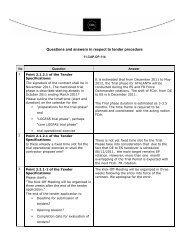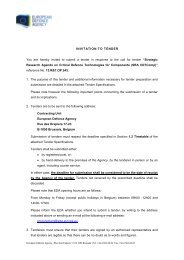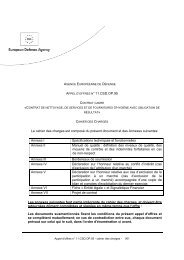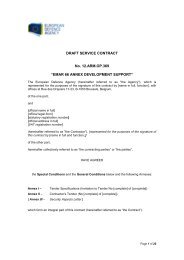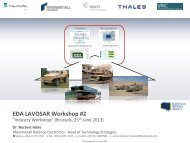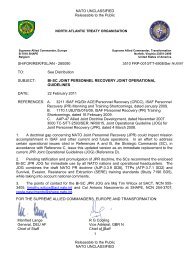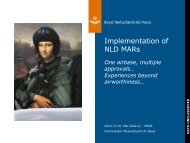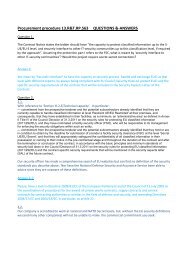capability development plan - European Defence Agency - Europa
capability development plan - European Defence Agency - Europa
capability development plan - European Defence Agency - Europa
You also want an ePaper? Increase the reach of your titles
YUMPU automatically turns print PDFs into web optimized ePapers that Google loves.
CDP CONTEXT<br />
The EDA Long-Term Vision (LTV) report outlined the sort of capabilities which Europe’s armed forces<br />
would need for possible <strong>European</strong> Security and <strong>Defence</strong> Policy (ESDP) military operations in the<br />
future. The broad endorsement of the LTV by EU <strong>Defence</strong> Ministers in October 2006 provided a solid<br />
foundation for ESDP <strong>capability</strong> <strong>development</strong> activities to be taken forward within a short-to-longer term<br />
perspective and set the baseline for an unique enterprise: to create a comprehensive and auditable<br />
overview of military <strong>capability</strong> trends and requirements, from today to 2025 and beyond, across all<br />
envisaged ESDP missions.<br />
In order to start this endeavour, the EDA Steering Board at the end of 2006 tasked the EDA to establish<br />
an ESDP Capability Development Plan (CDP), based on the Headline Goal 2010 process and the LTV,<br />
conducting a more detailed and evidence-based analysis of future <strong>capability</strong> needs and the mutual<br />
disclosure of national medium-to-long term <strong>plan</strong>ning.<br />
The detailed aim of the CDP were described as:<br />
- to make the LTV <strong>capability</strong> guidance more specific (and thus more useful);<br />
- to identify priorities for <strong>capability</strong> <strong>development</strong>; and<br />
- to bring out opportunities to pool and cooperate.<br />
The work was divided into four major strands:<br />
- Establishing the baseline of shortfalls against the Headline Goal 2010 and their relative priority;<br />
- Developing the LTV and by a series of <strong>capability</strong> studies on key issues;<br />
- Collating a database of Member States’ current defence <strong>plan</strong>s and programmes; and<br />
- Harvesting lessons for future <strong>capability</strong> from current experience.<br />
The work itself was taken forward in a series of workshops and working group meetings, mainly<br />
chaired by the EDA. It has been a most successful co-operative effort by all 26 pMS, committed to a<br />
single objective and supported by the EU Military Committee, the EU Military Staff, the General<br />
Secretariat of the Council. As might be expected for such a complex exercise, wide consultation,<br />
coordination and commitment were required.<br />
The initial CDP was presented to the EDA Steering Board on 8 July 2008. It will be a cornerstone of the<br />
<strong>Agency</strong>’s activities as it defines a framework for <strong>European</strong> governments to work together to improve<br />
the military capabilities required for ESDP operations now and beyond, including priorities and actions<br />
to undertake.<br />
The CDP is a unique tool, developed by the EDA’s participating Member States for use by the<br />
participating Member States. It provides a significant corpus of analysis of <strong>capability</strong> needs, <strong>capability</strong><br />
trends and potential <strong>capability</strong> shortfalls up to 2025 and a database of national <strong>plan</strong>s and priorities<br />
which will help pMS to identify and exploit areas of common interest.<br />
Although the <strong>development</strong> of the CDP in such a short time must be considered as a remarkable<br />
achievement by the pMS, it should be seen as one of a number of components, albeit a crucial one, of<br />
a wider objective to develop an end-to-end, <strong>capability</strong>-based process within the EU in order to<br />
converge towards a more common understanding of military needs in the 21st Century. Where the<br />
CDP succeeds in adding is in assisting all pMS to develop their national <strong>capability</strong> <strong>plan</strong>s in an<br />
appropriate balance of forces against ambition and resources, whilst providing a catalyst to identify and<br />
launch multinational collaborations for the <strong>development</strong> of new and enhanced capabilities. Therefore,<br />
the CDP is not, and must not be seen as, a Brussels-driven supranational <strong>plan</strong> with an aspiration to<br />
replace national decision-making.<br />
With this shared sense of vision, the CDP attempts to address the well-documented fragmentation in<br />
demand for <strong>European</strong> military capabilities - the lack of harmonised military requirements and<br />
comprehensive priorities - whilst trying to evolve from a culture which focused too much on force size<br />
and not enough on the mutual dependency of the determinant factors contributing to <strong>capability</strong>. It does<br />
this by identifying risks and challenges facing Member States across the full range of ESDP missions,<br />
from the defined Headline Goal military requirements and lessons from recent and current operations,<br />
EU NAVFOR-Atalanta safely escorts food aid convoy into<br />
Somalia, 9 February 2009 © EUNAVFOR<br />
5<br />
FUTURE TRENDS FROM THE CAPABILITY DEVELOPMENT PLAN




